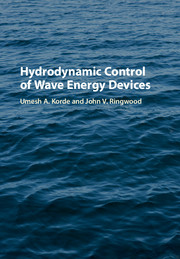Book contents
- Frontmatter
- Contents
- Preface
- Acknowledgments
- Part I Introduction
- Part II The Basics
- Part III The Hydrodynamics
- Part IV Velocity Control Using a Hydrodynamic Model
- Part V Control by Optimizing a Performance Index
- Part VI Toward Overall WEC System Hydrodynamic Optimization
- Part VII In Closing
- References
- Index
Part V - Control by Optimizing a Performance Index
Published online by Cambridge University Press: 05 September 2016
- Frontmatter
- Contents
- Preface
- Acknowledgments
- Part I Introduction
- Part II The Basics
- Part III The Hydrodynamics
- Part IV Velocity Control Using a Hydrodynamic Model
- Part V Control by Optimizing a Performance Index
- Part VI Toward Overall WEC System Hydrodynamic Optimization
- Part VII In Closing
- References
- Index
Summary
In this part, optimal controllers, based on the maximization of an energy performance index, are presented. The optimization problem can be solved either algebraically or numerically. Chapter 9 examines the special case of switching control, where the control force is a braking force to be switched on and off, and has proved popular in the WEC control systems literature. The approach seeks an optimum switching sequence by maximizing a performance index (absorbed energy) under a basic variational formulation, and explicitly uses the Pontryagin principle to derive that sequence. The need for information from the future is discussed, even though the control applied is nonreactive. The optimum switching sequence here represents an optimum latching sequence, where velocity is alternately locked and released to maximize the performance index. The use of a numerical optimization framework allows system amplitude, force, and velocity constraints to be explicitly considered in the optimized design, by virtue of a constrained optimization solution. In order to achieve an efficient numerical solution (considering real-time control requirements), a pseudo spectral representation is chosen for the system variables, which parameterizes the variables as a set of (Fourier) basis functions. Chapter 10 presents the basic constrained optimal control formulation for a single device (which can be multibody), while Chapter 11 examines the opportunity for coordinated control of arrays of WECs, examining both independent and global control strategies. As in Part IV, future wave elevation is required, and Chapter 12 examines wave forecasting strategies based on both autoregressive (using only historical information) and up-wave philosophies.
- Type
- Chapter
- Information
- Hydrodynamic Control of Wave Energy Devices , pp. 203 - 204Publisher: Cambridge University PressPrint publication year: 2016



